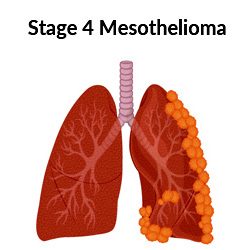What Is Stage 4 Mesothelioma?
Stage 4 mesothelioma is the final stage. This advanced stage of cancer is also known as end-stage or late-stage mesothelioma. Treatment options in this stage are mostly limited to palliative care, which aims to reduce symptoms and improve the quality of life while also prolonging survivability.
Palliative surgery and chemotherapy are offered based on a patient’s strength and overall health. Mesothelioma doctors typically do not present aggressive treatments for patients in this stage.
For many mesothelioma patients, remission is still possible in stage 4. However, life expectancy largely depends on the aggressiveness of the cancer and the patient’s response to treatment.
How Does Asbestos Cause Stage 4 Mesothelioma Tumors?
Asbestos fibers are long and thin, crystalline particles. As asbestos-containing materials break down, the damage releases fibers as microscopic dust into the air or water.
Inhaling or digesting these fine, needle-like fibers traps them in the lining of the lungs or other areas of the body. The shape and structure of asbestos fibers prevent the body from dissolving or expelling them.
Over time, these fibers trigger an immune response, causing inflammation, scarring in the tissues that damage DNA and leading to uncontrolled cellular replication and cancer.
Cancer that develops from asbestos fibers trapped in the pleura, the tissue lining the chest wall and lungs, is known as pleural mesothelioma.

Peritoneal mesothelioma is cancer caused by asbestos fibers stuck in the tissue surrounding the abdomen and abdominal organs. This tissue is called the peritoneum.
Characteristics of Stage 4 Mesothelioma
Most oncologists use the American Joint Committee on Cancer’s TNM classification system, which stands for Tumor Node Metastasis, to describe the extent of cancer.
- T: Smaller T1 or T2 tumors grow on one side of the chest and may be surgically removed. T3 and T4 tumors have grown into deeper tissues of the lung, spine or heart sac making surgery more difficult.
- N: Cancer cells may be present in lymph nodes on the same side as the tumor or have traveled to lymph nodes on the opposite side of the chest.
- M: A pleural mesothelioma patient can have any T or N value but must have distant metastasis (M1) to be considered stage 4.
- Tumors that may have spread locally or grown into the deeper tissues of the lungs, heart, ribs or spine.
- Lymph node involvement on one or both sides of the chest.
- Cancer cells present in distant organs, such as the brain or kidneys, in a process known as metastasis.
Other staging methods include the Brigham and Butchart systems. Dr. David Sugarbaker created the Brigham system, which outlines the role of surgery in each stage.
The Butchart staging system, much like the TNM, categorizes stage 4 mesothelioma on the presence and extent of metastasis.
Late Stages in Other Mesothelioma Types
Currently, there is no formal staging system for peritoneal or pericardial mesothelioma. However, physicians typically consider these diseases stage 4 if there is advanced tumor growth throughout the abdomen or metastasis.
The Peritoneal Cancer Index, or PCI, is a tool used to assess the extent of disease in peritoneal mesothelioma. Oncologists do not regularly use PCI as a predictor of survival, instead they use it to tailor treatment plans in the abdominal region.
Is Stage 4 Terminal?
Mesothelioma is terminal cancer and incurable. However, many patients go into remission, especially with treatment. The mesothelioma life expectancy at stage 4 depends primarily on the extent of the cancer progression and your response to therapy.

Symptoms of Stage 4 Mesothelioma
Compared to early-stage mesothelioma, significant symptoms are more present in stage 4. These symptoms are usually severe, and diagnosis occurs more frequently than in the early stages of mesothelioma.
Signs of Stage 4 Mesothelioma
- Coughing and wheezing
- Coughing up blood
- Chest or lower back pain
- Abdominal pain
- Difficulty breathing
- Fatigue
- Fever or night sweats
- Trouble swallowing
- Severe weight loss or lack of appetite
- Muscle weakness
- General discomfort
- Swelling of the face and arms
- Changes in blood cell or platelet counts
As tumors develop, pleural effusion may cause fluid accumulation between the layers of the pleura and lead to excess pressure on the lungs.
Patients may also experience cachexia, a metabolic disorder characterized by weight loss, muscle breakdown and general weakness.
Mesothelioma also causes high platelets and low red blood cell counts, known as thrombocytosis and anemia, respectively, which can worsen the impact of other side effects.
In many cases, mesothelioma symptoms mimic more common diseases such as pneumonia. Diagnosis can be difficult for a general practitioner. Oncologists or mesothelioma specialists diagnose most mesothelioma cases.
Late-stage peritoneal mesothelioma typically presents with gastrointestinal distress. Late-stage pericardial mesothelioma symptoms include irregular heart rhythms.
Stage 4 Mesothelioma by Type
The location and rate at which cancer spreads in stage 4 vary by mesothelioma type. Staging systems differ based on the specific diagnosis, but in all cases of late-stage mesothelioma, cancer has spread beyond its point of origin.
Stage 4 Pleural Mesothelioma
Malignant pleural mesothelioma is the most common form of this cancer, which has led to a widely approved method for staging the disease. The TNM staging system defines stage 4 pleural mesothelioma as cancer that has spread beyond the pleural lining of the lungs.
To be diagnosed with stage 4, cancer must have spread to a distant site from the pleural tissue in the thoracic cavity. Possible locations of metastasis include:
- Liver
- Bone
- Abdomen
- Opposite lung
- Distant lymph nodes
Treatment options in stage 4 also depend on epithelial, sarcomatoid or biphasic cell type. Patients with epithelial mesothelioma have the most treatment options
Stage 4 Peritoneal Mesothelioma
Peritoneal mesothelioma accounts for about 20% of all cases, but does not yet have an official staging system. However, mesothelioma specialists often use the Peritoneal Cancer Index to stage this type. These specialists typically classify peritoneal patients with extensive tumor presence throughout the abdomen as stage 4.
The PCI divides the abdomen into 13 regions and scores each area based on tumor size. The ratings are combined to provide a stage. In late-stage peritoneal mesothelioma, cancer has traveled to distant lymph nodes, tissues and organs.
Stage 4 Pericardial Mesothelioma
Pericardial mesothelioma is a rare form of the disease that develops in the heart sac and does not have an official staging system. Physicians typically use staging guidelines for other cancers to determine a stage for pericardial mesothelioma, but are often unable to diagnose the disease until its later stages.
Stage 4 Testicular Mesothelioma
Like other rare forms of this cancer, testicular mesothelioma does not have a recognized staging system. It is the form of mesothelioma with the least amount of documented cases, diagnosed in only 1% of all cases. Doctors consider this disease late -stage when it has spread to distant tissues, organs and lymph nodes.
Stage 4 Mesothelioma Prognosis and Life Expectancy
Fewer treatment options and more prevalent tumor growth lead to an average life expectancy of around 12 months for stage 4 mesothelioma patients who undergo treatment. The five-year survival rate for late-stage pleural mesothelioma is 8%, according to the Surveillance, Epidemiology and End Results Program of the National Cancer Institute.
Patients who decline treatment live an average of six months, but this varies based on overall tumor size and rate of growth.
In stage 4 mesothelioma, cancer has a likelihood of spreading further into the lungs or heart tissue. The most common causes of death are respiratory or cardiac failure.
- Age
- Gender
- Cancer cell type
- Treatment response
- Overall health
Pleural mesothelioma can be more challenging to treat than other types. Patients with peritoneal cancer tend to have better survival rates. Approximately 66% of late-stage peritoneal mesothelioma patients live past one year, and about 29% live for five years or more.
While the CDC does not track the mesothelioma stage type as it relates to the death rate, over 45,000 people per million die from mesothelioma. About 3,300 of those deaths are due to pleural mesothelioma, while peritoneal mesothelioma accounts for about 1,800.
Roughly 74 people out of every million will die of pericardial mesothelioma. There is insufficient data on the mortality rate of testicular mesothelioma due to its rarity.
With a successful response treatment and positive prognostic factors, many patients often live longer than 12 months. Patients with epithelioid cell type tumors may have better outcomes from surgery, and younger patients without underlying medical conditions might respond better to treatment.
Is There a Cure for Stage 4 Mesothelioma?
There is currently no cure for any stage of mesothelioma. Most treatments in stage 4 are palliative options and aim to decrease the severity of symptoms to improve quality of life.
Oncologists do not recommend aggressive tumor-reduction surgeries in the final stages of mesothelioma because of the spread of cancer to other areas in the body.

Late-Stage Mesothelioma Treatment Options
Treatment options for mesothelioma at stage 4 include chemotherapy, palliative surgery and radiation therapy. Clinical trials and complementary medicine provide alternative avenues for patients seeking novel methods or palliative approaches.
Surgery
Stage 4 pleural mesothelioma patients are not eligible for extrapleural pneumonectomy or pleurectomy with decortication. These surgeries are unable to remove the majority of tumor mass in stage 4. Treatment plans will depend on how far cancer has spread.
Palliative surgical options for stage 4 mesothelioma patients will remove tumor mass from areas to improve symptoms such as difficulty breathing or chest pain. This process is known as debulking and is a less extensive surgery than mesothelioma surgical options offered in earlier stages.
- Thoracentesis: This procedure uses a needle inserted into the pleural space between the lungs and chest wall to drain excess fluid and improve breathing effort. The process typically takes between 10 and 15 minutes.
- Pleurodesis: Slightly more advanced than thoracentesis, this surgery fuses the pleural layers after removing the excess fluid to prevent any further accumulation. It is a more permanent solution than thoracentesis.
- Paracentesis: A surgeon uses a needle to drain excess fluid from the abdominal space to relieve gastrointestinal pain. This procedure is similar to thoracentesis but is more common in patients with peritoneal mesothelioma.
- Pericardiocentesis: Fluid may accumulate in the pericardium, the sac that surrounds the heart. This surgery uses a needle to drain the excess fluid, known as pericardial effusion, to reduce chest pain and prevent irregular heart rhythms.
Chemotherapy
Chemotherapy slows tumor growth and is the most common treatment option for stage 4 mesothelioma. Oncologists typically prescribe a combination of pemetrexed (Alimta) and cisplatin. In some cases, chemotherapy may also shrink tumors.
In addition to prolonging survival, patients often receive chemotherapy with other therapies in a multimodal approach that reduces symptoms and can improve their mesothelioma prognosis.
Mesothelioma specialists sometimes prescribe hyperthermic intraperitoneal chemotherapy (HIPEC) for late-stage peritoneal mesothelioma. However, specialists do not indicate this procedure for patients with a high Peritoneal Cancer Index score.
Radiation
Palliative radiation therapy is another option that oncologists often combine with other treatments. This therapy uses high-energy beams to kill cancer cells in a specific and discrete location while minimizing damage to neighboring healthy tissue.
Radiation can help stage 4 patients with painful chest wall tumors by shrinking them to reduce pain and pressure on the nearby nerve or organ tissues.

Palliative Care
Palliative care is the umbrella term for treatments that do not intend to cure the disease. These therapies aim to improve the quality of life and increase overall function by controlling pain and alleviating symptoms.
- Oral Medications: Medications can help reduce pain and swelling. Physicians might also prescribe medications to improve breathing, reduce anxiety or prevent sleep disturbances.
- Oxygen Therapy: If respiratory symptoms are severe, and oxygen levels are consistently low, physicians may prescribe portable oxygen to help with daily activities and mobility.
- Physical Therapy: Training muscles and joints to offset general weakness through physical therapy and occupational therapy can improve daily activity and range of motion.
Palliative chemotherapy and radiation can help you feel better and extend survival by reducing cancer-associated pain. Palliative surgery is an option that drains fluid buildup around the lungs to improve breathing effort.
Respiratory therapy is another palliative option that can train patients to breathe with improved effort and increase overall lung function and oxygen saturation.
Complementary Treatment
Complementary therapies, such as yoga and acupuncture, may also improve overall health and empower patients to fight cancer.
Many stage 4 mesothelioma patients integrate complementary and alternative medicine into their treatment. For example, massage and herbal remedies have eased chemotherapy symptoms or side effects of some mesothelioma survivors, enhancing their quality of life.
These practices offer patients more control over their treatment plans and provide a broader range of options. Changes in lifestyle decisions, such as improved diet and exercise, can also increase overall health, boost the immune system and prolong survival.
Clinical Trials
Some treatment options for stage 4 mesothelioma patients are only available through clinical research trials. These studies allow patients the opportunity for otherwise unavailable and potentially effective therapies such as immunotherapy, gene therapy and new chemotherapy options.
Clinical research trials afford one of the best chances at increased survival for stage 4 mesothelioma patients. However, in some cases, few or only one patient in a mesothelioma clinical trial might respond positively to the drug or therapy.
Some immunotherapy medications have shown promising results for many patients in clinical trials. These medications use the body’s immune system to attack and eliminate cancer cells with fewer symptoms compared to chemotherapy.
Examples of immunotherapy medications include pembrolizumab (Keytruda) and nivolumab (Opdivo).
- Anti-angiogenic Medications: These medications prevent tumors from developing blood vessels and slow their rate of growth and metastasis.
- Photodynamic Therapy: This intraoperative procedure uses light and a chemical substance to kill tumor cells. In a 2016 study, this method increased disease-free survival by over 12 months.
Scientists continue to research new methods for treating advanced-stage cancer, and clinical research trials are always enrolling.
Support and End-of-Life Planning
Stage 4 mesothelioma patients can take an active role in their treatment plan by frequently communicating with their medical team and support network. Patients who advocate for themselves find fulfillment in being involved with their end-of-life care and planning.
Communicating clearly and often with family and friends makes it evident what your wishes are and why these decisions are essential to you. Patients have less anxiety when they are sure their loved ones will honor their requests.
Documentation is also vital during end-stage mesothelioma planning. Working with a palliative care specialist or hospice provider can assist with care decisions and appropriate documentation.
Some families may need more care assistance as cancer progresses. Hiring a professional caregiver or home health aide ensures medical caregiving and household duties don’t cause excess stress.
A hospice program may be the right choice if the patient requires constant medical care that caregivers or health aides cannot provide at home.
Many patients also seek help from online support groups and care networks. Connecting with other patients going through a similar process provides motivation and empowers patients to advocate for their care.
By taking control of your mesothelioma diagnosis and care options, you provide yourself agency that will help you manage many aspects of your cancer.
Through several treatment options, clinical trials and successful planning, mesothelioma survivors have beaten the odds, and more patients can hope to live longer with a stage 4 diagnosis.
Common Questions About Stage 4 Mesothelioma
- How long can you live with stage 4 mesothelioma?
-
The average pleural mesothelioma life expectancy is 12 months with treatment. However, this number decreases as the disease progresses and spreads. Approximately 8% of stage 4 mesothelioma patients live beyond five years.
- What happens in the final stages of mesothelioma?
-
In the fourth and final stage of pleural mesothelioma cancer, tumors have spread to distant sites within the body. Cancer cells may be present in the brain, kidneys or other organs. Patients are likely to experience severe symptoms such as respiratory distress, fever and extreme weight loss.
- Is stage 4 pleural mesothelioma always terminal?
-
Mesothelioma is terminal cancer, and the prognosis for mesothelioma patients with stage 4 disease is generally poor. However, some survivors have lived beyond their initial life expectancy through treatments such as chemotherapy and radiation. Patients can improve their mesothelioma prognosis with experimental therapies offered through clinical trials and by maintaining good overall health.



